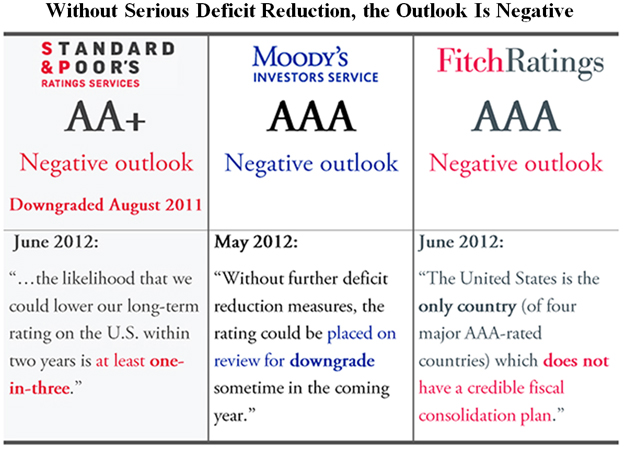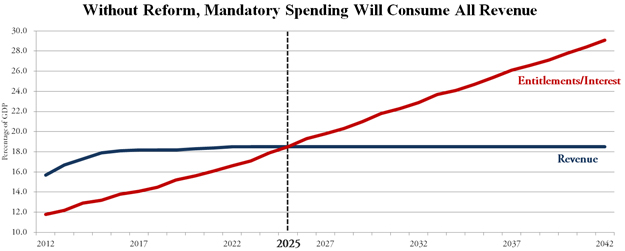Fix Fiscal Cliff, Then Solve Spending
America's fiscal policy is currently focused on the impending “fiscal cliff” that will cause taxes to increase and spending to be arbitrarily cut at the beginning of 2013. The spending cuts will happen through a sequester that is part of the Budget Control Act (BCA). The BCA took an important step toward fiscal sanity by cutting spending by $2.1 trillion over 10 years.
Further spending restraint is needed, as shown by Standard & Poor’s downgrade of the U.S. credit rating and negative outlooks on our credit from Moody’s and Fitch. The U.S. can avoid any immediate negative consequences of the 2013 sequester by passing a long-term spending reform package that puts the U.S. on a path to fiscal stability.
A Big, Long-Term Approach Will Accomplish More
The House of Representatives passed a bill earlier this year to cancel much of the 2013 sequester and replace it with bigger and more precise cuts. The House’s approach recognizes that the 2013 sequester can be replaced as long as real and lasting spending cuts are substituted in its place. What’s more, entitlement reforms and other spending controls will strengthen our fiscal position more than the 2013 sequester will. These reforms would not cut as much as the sequester in fiscal year 2013, but they would help stabilize U.S. finances better over the long term.
The total 2013 sequester only accounts for 11 days of spending under the President’s fiscal year 2013 budget. In comparison, deficits for the next 25 years are over $58 trillion. More needs to be done to rein in federal spending.

Source: CBO Alternative Fiscal Scenario; in 2012 dollars
Spending reforms will be needed eventually, and the longer we wait the more expensive they get.

Source: CBO Alternative Fiscal Scenario
U.S. Must Stabilize Debt by Spending Less
Future economic growth will require large spending reductions that begin to stabilize debt as a share of GDP. The House Republican budget proposed more than $5 trillion in spending cuts over 10 years compared to the President’s budget. The President’s Fiscal Commission proposed $4 trillion in deficit reduction in less than a decade compared to a realistic baseline. And the so-called “Grand Bargain” President Obama backed away from was reported to cut $4 trillion.
The credit rating agencies have repeatedly said that the U.S. needs a large fiscal stabilization plan that will put the country on sound footing once and for all.

Interest and Entitlements Drive This Spending Train
Spending on interest and entitlements will soon squeeze out other spending.

Source: OMB, CBO Alternative Fiscal Scenario
The surest way to reduce interest costs is to reduce the principal of our debt by not spending more money than the government takes in. Yet the largest federal category of outlays, mandatory spending such as entitlements, is the smallest portion of the 2013 sequester.

Source: CBO
Entitlements and interest payments will take up all revenue after fiscal year 2025.

Source: CBO Alternative Fiscal Scenario
Our Children Will Pay for Democrats’ Failure to Act
The 2013 sequester is important. But even more important is putting in place a long-term, multi-trillion dollar plan that reduces deficits by cutting spending. Our public-debt-to-GDP ratio is already 73 percent. If we continue on our current path and allow this ratio to exceed 90 percent, economists Carmen Reinhart and Ken Rogoff tell us that our GDP could grow by an average of one percent less. Under President Obama’s policies -- which delivered 1.7 percent growth last year and even less in the most recent quarter -- the loss of another percentage point of growth would be disastrous.
What’s more, we owe it to future generations to straighten out Washington’s finances as soon as possible. By passing on such a large national debt, Democrats are burdening young Americans with debt that they cannot consent to in order to pay for benefits they will not see. Young people will never enjoy the benefits of programs like Social Security and Medicare if we do not make reforms now to ensure those programs will be there in the future.
By forcing action, the sequester presents an opportunity to make 2013 the year of real reform. But only if Democrats give up their stated intention to take the country over the fiscal cliff and embrace the opportunity.
Next Article Previous Article
